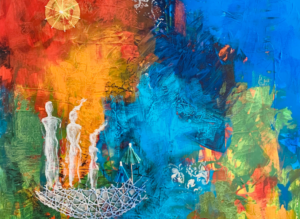A Bluegrass Passover with Nefesh Mountain
Explore part of the Art D’var series exploring the Torah portion through art.
Published Apr 4, 2024

ROLLING STONE
Art D’var is an arts approach to the weekly Torah portion. Just as Torah is a framework for Jewish life that must be unpacked and investigated from many angles to understand the depth of its content and applicability to our own lives, so is great art. This series illuminates works of art that help contemporize the ancient text of the Torah.
Beshalach
16th weekly Torah Portion
Exodus 13:17-17:16
6,423 Hebrew letters
1,681 Hebrew words
116 verses
Beshalach, which means “when he sent” in Hebrew, is the Torah portion that recounts the story of the Israelites crossing the parted Red Sea – the magical and iconic moment of freedom when the Israelites escaped the enslavement of the Egyptians.
A central part of this story is the Song of the Sea, Shirat Hayam (Exodus 15: 1b-18), a poetic tribute to the Israelites’ miraculous deliverance from the pursuing Egyptians. This poem is so important that it’s recited daily in the Jewish morning shacharit service, and also comprises the first ode or hymn of the Christian Eastern Orthodox canon where it is known as the Song or Ode of Moses.
Song of the Sea is an epic celebration of freedom – sung in the portion not by the men who led the Israelites, but by the women, led by Miriam, the sister of Moses and Aaron.
Then Miriam the prophetess, Aaron’s sister, took a timbrel in her hand, and all the women went out after her in dance with timbrels. And Miriam chanted for them: Sing to the LORD, for He has triumphed gloriously; Horse and driver He has hurled into the sea.
– Exodus 15:20-21
When I envision these women dancing, it’s the ultimate elation, so narrowly and completely just escaping the Egyptians. This moment of beauty marks the passage from slavery into freedom. And when I think of an artist who, like Miriam, who uses music and movement to help find the joy to keep moving forward even in the most difficult of times, I think of Doni Zasloff, singer of Nefesh Mountain bluegrass band.
Like Miriam, Doni uses her voice and her soul to lead us with music she creates with her husband Eric Lindberg and bandmates of Nefesh Mountain, a Rolling Stone top-ranked bluegrass band – known for their top musical skill and amazing Jewish soul.
The 2019 Nefesh Mountain album Songs for the Sparrows is an eclectic mix of klezmer-tinged bluegrass. One of the final songs, Tree of Life, is a tribute to the 2019 horrific shooting at Tree of Life Synagogue in Pittsburgh. Following the shooting, Doni and Eric did what felt natural to them – they wrote a song. This album ranges from meditative to joyous, spanning the range of the Jewish experience.
Wanderlust, the opening song on the Songs for the Sparrows album, encapsulates the vibe I think of when I think of the women and their timbrels – hopeful music, guiding us towards a better future.
“Light these days ahead for us.” – Wanderlust
JArts’ mission is to curate, celebrate, and build community around the diverse world of Jewish arts, culture, and creative expression. Our vision is of a more connected, engaged, and tolerant world inspired by Jewish arts and culture.
Reflections
-
1.
In some ways, the animation of this video feels like a modern-day illustration of the Israelites passing through the parted sea. How does it make you reflect on Passover?
-
2.
Bluegrass doesn’t have a long Jewish tradition, and yet there is such a natural synergy in the use of song and poetry to transmit stories. How does the bluegrass resonate for you?
Want more?
Get curated JewishArts.org content in your inbox


